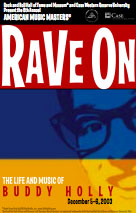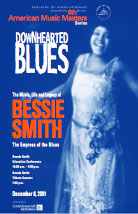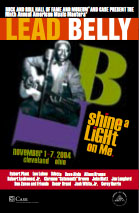Each fall, when banners and posters all over Cleveland announce the latest installment in the American Music Masters series, they have the look of instant collector's items. If you'd kept every one from the past 12 years, you could fill a gallery with tributes to some of the most influential figures in American popular music.

Here, aslant against an orange background, would be Hank Williams's attenuated silhouette ("Honky Tonk Blues"). Here would be Muddy Waters, emerging from the obscurity of a nightclub stage ("Got My Mojo Working"). Here would be Bessie Smith ("Empress of the Blues"), Buddy Holly ("Rave On"), and Louis Jordan ("At the Swing Cat's Ball"), to name just a few.
Meanwhile, the people who have attended American Music Masters concerts, exhibits, and symposia over the years have been storing up memories. They can tell you how Jerry Lee Lewis, the most recent honoree, sat down at a piano at the State Theatre in Playhouse Square and surprised everyone by performing "Over the Rainbow." They remember that Lou Rawls made one of his last appearances when he came to Cleveland to honor Sam Cooke, with whom he'd recorded "Bring It on Home to Me" in 1962.
All of this has come about through a partnership between Case Western Reserve University and the Rock and Roll Hall of Fame and Museum. In 1996, the two institutions mounted a week of performances and educational programs devoted to Woody Guthrie. Every year since, they have brought together scholars, journalists, musicians, and increasingly large audiences to celebrate pioneers of American music—folk singers and blues singers, country and western artists, jazz innovators, pop idols—who were also the forebears of rock and roll.
"The idea," says Mary E. Davis, associate professor of music and the College's liaison to the Rock Hall, "is to take a week to think about the contributions that each honoree has made not only to rock and roll and its history, but also to cultural, political, and social life in this country—to the fabric of everyday American life, really. We try to illuminate the ways in which these artists transcend music alone and have an impact in the broader realm."

It was, in part, the chance to collaborate with the Rock Hall that prompted Davis, who is also associate director of the Baker-Nord Center for the Humanities, to join the College in 1998. Working with the museum's education department, she helps to plan each year's series of club concerts, films, and public school programs. In addition, she organizes a public conference held at the university. This event includes speakers who were directly involved in an honoree's life and career—siblings, fellow musicians, managers—as well as biographers and music historians.
"When you actually hear from the people who were in the room when the music was being created for the first time, the people who were on the road when the crowds went wild, it all becomes alive in a way that I don't think happens anywhere else," Davis says.
Each American Music Masters week culminates in a tribute concert in which guest artists perform songs made famous by the honoree. Participants over the years have included Aretha Franklin, Bruce Springsteen, Elvis Costello, Alison Krauss, John Mellencamp, and Kris Kristofferson. All of the artists donate their time to the program and draw enthusiastic audiences.
"One of the really gratifying things about working on this project is that it has a huge reach into many different communities," Davis says. "There are many fans who are drawn to our campus, and to Cleveland, because they want to participate in the events that honor an individual artist. But over the years, people have also come to recognize the American Music Masters brand."
In her own research, Davis specializes in an area that may seem worlds away from American rock and roll—French musical and cultural life in the 1910s and 1920s. Her first book, Classic Chic: Music, Fashion, and Modernism, explored the aesthetic and cultural connections between Parisian high fashion in the early 20th century and the modernist movement in music, ballet, and the visual arts; her second was a biography of composer Erik Satie.
On the other hand, Davis is also the editor of a forthcoming book about country singer Jimmie Rodgers, whose early records date back to the 1920s and who was named an American Music Master in 1997.

In her contribution to the book, Davis traces the folk song antecedents of Rodgers's "Gamblin' Bar Room Blues"—a work that doesn't ordinarily attract the attention of Satie scholars. She points out, however, that classical and popular composers on both sides of the Atlantic were "using musical materials from various sources to create something new. Satie, for example, was always borrowing elements from pop songs and French folk songs. You would recognize them and say, That reminds me of. . . . They would trigger a whole set of allusions that enriched your experience of hearing the music."
Davis notes that for anyone interested in how music and fashion are related, the history of rock and roll is as rich a field for exploration as the early modernist period in Paris. "You can't imagine Elvis without the black leather jacket or the white jumpsuit," she explains. "You can't imagine Motown without the spangles, or Aerosmith without Steven Tyler's scarf. The visual impact of fashion is important and reinforces what's going on in the sound. And that was true with composers and haute couture at the beginning of the 20th century."
Davis realizes that not everyone sees a project like American Music Masters as having scholarly gravitas. But for her, the annual immersion in a performer's life and work is "an incredible learning experience," and she has been gratified by the public's embrace of the series.
"The community of people for whom popular music is meaningful is vast," she explains. "This music has been the soundtrack of their lives. And when you reach out to that community, you get an enormous and very warm response."
